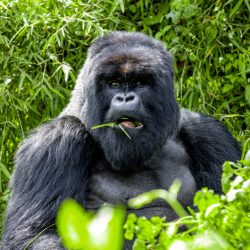A Snapshot of Conservation Incentives in Rwanda
Blog | 16/09/10
The women of Kinigi and Nyange Sector know what they are up against- population density is high and their farms are small. Seeking alternatives, they now sit together two days a week, meticulously binding and weaving colorful baskets. Women selling handicrafts to tourists might be something you can see in many parts of the world, but here IGCP plans to make it work for not only the women and tourists, but for mountain gorilla conservation.
Successful conservation incentives, developing income-generating opportunities for people and communities that are directly linked to conservation, do not happen overnight. It takes a concerted effort and a good eye for seeing opportunities as they arise. When something starts to work, it is augmented and supported to have the biggest effect possible.
Here, we highlight a few of the ongoing conservation incentive programs that IGCP is involved with in Rwanda. Pictures that accompany this post can be found on Flickr.
Baskets and Carving
About 100 women and 20 men are active in cooperatives producing handicrafts that are then sold in a store located adjacent to the park headquarters in Kinigi. You may also purchase these baskets online.
Recently, thanks to a group of private donors to IGCP, the women now have a dry place to work during the frequent heavy rains. Those women with small children in tow are especially appreciative of the shelters, one located in Kinigi and another in Nyange. IGCP is now looking forward to facilitate the sustainable production of the materials needed in the local area, using the women’s buying power to offer alternative income to other community members.
The male members of the cooperative work in their own shop carving gorilla statues of different sizes and also decorative walking sticks. Their wood of choice comes from the jacaranda tree. Although some replanting of trees is already occurring, IGCP will be looking for ways to help ensure a steady and sustainable supply of jacaranda from areas outside of the forest.
Beekeeping and Honey
It wasn’t long ago that beekeepers kept their traditional beehives within the national parks. Traffic in and out of Volcanoes National Park can cause habitat degradation and can potentially increase disease transmission to mountain gorillas. In addition, smoke for clearing bees can also lead to destructive forest fires.
There has been a successful effort by IGCP, in solidarity with the Rwanda Development Board (RDB) and local authorities, to encourage movement of beehives to outside the park. Now many beekeepers have organized into cooperatives that work together, pooling resources and coordinating collection and processing. Traditional hives abound and can be found in the hundreds poised on top of the buffalo wall (pictured above and more below). Modern hives, if constructed properly, can increase honey production and therefore increase income to beekeepers. Efforts are underway to improve local production of these modern hives.
Buffalo Walls
Conflict between people and wildlife can be a big threat to conservation. Communities are slow to participate in conservation when they are regularly affected by buffalos and elephants that leave the park in search of their crops and water during the dry season. In an effort, again with the Rwanda Development Board and local communities, IGCP facilitated the building of a stone wall around the park to deter buffalo and elephants from leaving the park to pillage local farms.
The walls have been in place for many years now, but buffaloes are clever and strong enough to penetrate the wall. Regular maintenance is needed to keep it up. In addition, communities have developed modifications of the original design to improve its efficiency. In places where the soil permits, trenches have been dug on the park side of the wall and in places where the soil is too rocky, the wall has been modified to be 1 ½ meters tall and two meters wide.
In one sector alone, over 150 “crop rangers” spend part of every Friday repairing the wall and the male members take turns guarding the wall to protect crops.
Rainwater Harvesting
Although the region near Volcanoes National Park is known for its heavy rains, sources of water are still scarce for local communities. Many people go into the park to look for water and again, the disruption to habitat and potential for disease transmission is a threat to mountain gorillas.
IGCP, through multiple donors and in collaboration with many partners, is working to provide rainwater harvesting systems for individual households located close to the park. Although these systems are built for households, the benefits are wider-reaching. Many neighbors share with each other. And now a there are 24 women and six men who are trained to build the tanks themselves.
Letting Local Communities Choose
One of the most exciting conservation incentive projects that IGCP is heavily involved with is with SACOLA, the Sabyinyo Community Livelihoods Association. SACOLA is now using revenue from the fabulous Sabyinyo Silverback Lodge (around 20,000 USD per month) to fund their own community projects. Twenty comfortable houses have been built for the poorest of the area and more are being planned. Rainwater harvesting systems and classrooms have been built. SACOLA supports the maintenance of the buffalo wall. SACOLA has also developed (with assistance and support from IGCP, USAID, RDB, and UNDP) a cultural center and community walk. SACOLA now has the resources to continue conservation incentives on their own.
Each of these initiatives deserves more in-depth coverage. And you’ll find it here in coming months on this blog.


